Innovative and Patented Liposome-Based Drug Carriers
Abstract
1. Introduction
2. Patent Searching for Liposome-Based Drug Carriers
3. Processes for the Liposomes’ Production
3.1. Overview of Patented Liposome Production Processes
3.1.1. Conventional Liposome Production Processes
| Title | Publication No. [Reference] | Applicants | Earliest Priority |
|---|---|---|---|
| Encapsulation of chemical substances—in liposomes for medicinal use | FR2221122B1 [46] | Bayer AG | 12 October 1971 |
| Fusogenic liposomes and methods of making and using same | EP0758883B1 [47] | The Liposome Company, Inc. | 12 April 1994 |
| Liposome sensitive to pH or reductive condition and processes for the preparation thereof | KR100853172B1 [48] | Postech Acad Ind Found | 4 April 2007 |
| Improved lipid formulation | US8158601B2 [49] | Chen J.; Ansell S.; Akinc A; Dorkin J.R.; Qin X.; Cantley W.; Manoharan M.; Rajeev K.G.; Narayanannair J.K.; Jayaraman M.; Alnylam Pharmaceuticals, Inc. | 10 June 2009 |
| Improved lipid formulation | US8802644B2 [50] | Chen J.; Ansell S.; Akinc A; Dorkin J.R.; Qin X.; Cantley W.; Manoharan M.; Rajeev K.G.; Narayanannair J.K.; Jayaraman M.; Tekmira Pharmaceuticals Corp | 10 June 2009 |
| Liposome formulation and manufacture | EP3135274B1 [51] | Biorest Ltd. | 14 March 2013 |
| Preparing method of proliposomes | KR101682821B1 [52] | Seoul National University R&DB Foundation | 21 July 2015 |
| Platinum-modified liposome as well as preparation method and application thereof | CN107550865B [53] | Guangzhou Heji Biological Tech Co., Ltd. | 21 June 2017 |
| Compositions and systems comprising transfection-competent vesicles free of organic solvents and detergents and methods related thereto | EP3864163B1 [54] | The University of British Columbia | 9 October 2018 |
| Alkannin active drug-loading liposome as well as preparation and application thereof | CN115105473B [55] | Suzhou Yutai Pharmaceutical Tech Co., Ltd. | 19 Marc 2021 |
| Hydrogel–liposome combined drug delivery system as well as preparation method and application thereof | CN115192581B [56] | The First Affiliated Hospital of Shandong First Medical Univ. Shandong Qianfoshan Hospital | 21 July 2022 |
| Preparation method and application of acid-response-type drug delivery platform based on liposome nano-vesicles | CN115337267B [57] | University of Science and Technology China | 15 August 2022 |
| Probucol liposome for hypercholesterolemia, preparation and preparation method of probucol liposome | CN115364056B [58] | Pingdingshan No. 2 People’s Hospital, Shangdong New Time Pharmaceutical Co., Ltd. | 26 August 2022 |
| Thermo-sensitive nano-liposome capable of realizing stepped release of active matters and application of thermo-sensitive nano-liposome | CN115590818B [59] | University of Jiangnan | 9 September 2022 |
| Alendronate sodium liposome and preparation thereof | CN116650418B [60] | Zhengzhou Central Hospital | 5 June 2023 |
| A stabilized nano-liposome delivery carrier comprising nucleic acid and a method for preparing the same | KR102678046B1 [61] | Binotec Co., Ltd. | 22 October 2023 |
| Anti-alopecia hair-strengthening nano-liposome and preparation method thereof | CN118001207B [62] | Wangshuhe Biomedical Wuhan Co., Ltd. | 2 February 2024 |
3.1.2. Novel Liposome Production Processes
| Title | Publication No. [Reference] | Applicants | Earliest Priority |
|---|---|---|---|
| Novel functionalized liposomes and a process for production thereof | EP0247497B1 [66] | Wako Pure Chemical Industries, Ltd. | 20 May 1986 |
| Synergistic liposomal formulation for the treatment of cancer | EP3046542B1 [67] | Council of Scientific and Industrial Research | 18 September 2014 |
| Liposome compositions and methods of use thereof | EP2603201B1 [68] | Rhode Island Board of Governors for Higher Education; Yale University, Inc. | 12 August 2011 |
| Targeted hybrid exosome loaded with curcumin and miR140 as well as preparation method and application of targeted hybrid exosome | CN117965429B [69] | Sichuan University | 29 March 2024 |
| Hybridosomes, compositions comprising the same, processes for their production, and uses thereof | US10561610B2 [70] | Anjarium Biosciences AG | 20 January 2015 |
| Hybridosomes, compositions comprising the same, processes for their production, and uses thereof | US11484500B2 [71] | Anjarium Biosciences AG | 2 January 2020 |
| Process for the production of hybridosomes | EP3096741B1 [72] | Anjarium Biosciences AG | 21 January 2014 |
| Preparation method of exosome bionic preparation for synergistically promoting wound healing and preparation thereof | CN113577272B [73] | China Pharmaceutical University | 28 July 2021 |
| Co-loaded liposome and preparation method thereof | CN116270473B [74] | Chengdu Jinrui Found Biotechnology Co., Ltd. | 25 May 2023 |
| A method for preparing a functional synthetic cell in form of a giant unilamellar vesicle | EP3630068B1 [75] | Max-Planck-Gesellschaft zur Förderung der Wissenschaften e.V. | 16 June 2017 |
| PEG2, N-lipid derivative-modified nano-carrier, preparation method and application | CN113350512B [76] | Shenyang Pharmaceutical University | 7 June 2021 |
| Compound responding to endocytosis and release and application thereof | CN113683769B [77] | Shanghai Jiao Tong University | 19 May 2020 |
| All-trans retinoic acid liposome preparation and preparation and application thereof | EP3501500B1 [78] | Shanghai Jiao Tong University | 18 August 2016 |
| Granular-type adjuvant as well as preparation method and application thereof | CN108324938B [79] | Institute of Process Engineering, Chinese Academy of Sciences | 1 March 2018 |
| mRNA–liposome complex and application thereof | CN112107680B [80] | Zhejiang Zhida Pharmaceutical Co., Ltd. | 21 June 2019 |
| Drug delivery vector and pharmaceutical formulation | CN114007653B [81] | Fudan University; JSR Corporation | 5 May 2019 |
| Patent Title | Publication No. [Reference] | Applicants | Earliest Priority |
|---|---|---|---|
| A delivery device | EP3334413B1 [82] | PTT Holding Aps | 11 August 2015 |
| Pharmaceutical composition, preparation, and uses thereof | EP3236934B1 [83] | Curadigm SAS | 25 November 2014 |
| Method for preparing medicinal extract containing intermediate peashrub seeds | CN104382984B [84] | Northwest Institute of Plateau Biology Chinese Academy of Sciences | 1 December 2014 |
| Preparation method of temperature and fluorescence probe of liposome loaded with gold nanocluster and anti-cancer drug | CN103599070B [85] | Shanghai Jiao Tong University | 26 November 2013 |
| Antitumor liposome formulation and method for producing the same | JP4715133B2 [86] | Konica Minolta Med and Graphic | 26 August 2004 |
| Method for producing liposome-containing formulation and liposome-containing formulation | JP4599849B2 [87] | Konica Minolta Med and Graphic | 18 February 2004 |
| Method for producing liposome-containing formulation and liposome-containing formulation | JP4649841B2 [88] | Konica Minolta Med and Graphic | 18 February 2004 |
4. Liposome-Based Drug Delivery Systems
4.1. Liposome-Based Drug Carriers for Cancer Treatments
| Patent Title | Publication No. [Reference] | Applicants | Earliest Priority |
|---|---|---|---|
| Controlled drug release liposome composition | EP2968146B1 [92] | Taiwan Liposome Company Ltd.; TLC | 15 March 2013 |
| Method of reconstituting liposomal annamycin | US11980634B2 [93] | Board of Regents, The University of Texas System | 28 June 2019 |
| Protamine short-peptide-modified paclitaxel liposome and preparation method thereof | NL2033676B1 [94] | Institute of Biological Resources, Jiangxi Academy of Sciences; Anhui Zishanyuan Ecological Agricultural Technology Co., Ltd. | 6 December 2022 |
| Paclitaxel liposome composition for treatment of cancer and preparation thereof | EP1332755B1 [95] | Nanjing Zhenzhong Bioengineering Comp. Ltd. | 19 October 2000 |
| Liposome of irinotecan or its hydrochloride and preparation method thereof | EP2508170B1 [96] | Jiangsu Hengrui Medicine Co., Ltd.; Shanghai Hengrui Pharmaceuticals Co., Ltd. | 3 December 2009 |
| Irinotecan liposome preparation and preparation and application thereof | CN109260155B [97] | HighField BioPharmaceutical Corporation | 5 November 2018 |
| Pegylated lipid, liposome modified by pegylated lipid, pharmaceutical composition containing liposome, and preparation and application of pharmaceutical composition | CN115197078B [98] | Xiamen Sinopeg Biotech Co., Ltd. | 8 April 2021 |
| Liposomes with ginsenoside as membrane material and preparations and use thereof | EP3337456B1 [99] | Shanghai Ginposome Pharmatech Co., Ltd. | 19 August 2015 |
| Dianhydrogalactitol, diacetyldianhydrogalactitol or dibromodulcitol to treat non-small-cell carcinoma of the lung and ovarian cancer | EP3125920B1 [100] | Del Mar Pharmaceuticals Inc. | 4 April 2014 |
| Multicellular targeting liposome | JP7470418B2 [101] | Shanghai Jiao Tong University | 14 September 2017 |
| Tumor-targeted therapeutic drug carrier as well as preparation method and application thereof | CN102133404B [102] | Chengdu Nuoen Biological Technology Co., Ltd. | 23 March 2011 |
| Application of redox-responsive chitosan-liposome | CN107982547B [103] | University Dalian Minzu | 27 July 2017 |
| Pharmaceutical composition comprising jasmonates | KR101751918B1 [104] | Fehr Pereira Lopes, Jose E. | 15 July 2008 |
| Liposomal delivery of vitamin-E-based compounds | AU2002361812B2 [105] | Research Development Foundation | 19 December 2001 |
| Liposomes useful for drug delivery | US8147867B2 [106] | Hermes Biosciences Inc. | 3 May 2004 |
| Liposomes useful for drug delivery | US8703181B2 [107] | Merrimack Pharmaceuticals | 3 May 2004 |
| Liposomes useful for drug delivery | US9782349B2 [108] | Ipsen Biopharma Ltd. | 11 December 2015 |
| Preparation method of temperature and fluorescence probe of liposome loaded with gold nanocluster and anti-cancer drug | CN103599070B [85] | Shanghai Jiao Tong University | 26 November 2013 |
| Granular-type adjuvant as well as preparation method and application thereof | CN108324938B [79] | Institute of Process Engineering, Chinese Academy of Sciences | 1 March 2018 |
| Interleukin-2 variant proteins fused to human IgG4 Fc and uses thereof | US11896648B2 [109] | Gilead Sciences, Inc. | 22 October 2020 |
4.2. Liposome-Based Drug Carriers for Nucleic Acid Delivery
| Patent Title | Publication No. [Reference] | Applicants | Earliest Priority |
|---|---|---|---|
| Messenger RNA vaccines and uses thereof | CN112384205B [110] | Translate Bio, Inc. | 30 May 2018 |
| Methods and compositions for delivering mRNA-coded antibodies | EP2970456B1 [111] | Translate Bio, Inc. | 14 March 2013 |
| Preparation and storage of liposomal RNA formulations suitable for therapy | US11395799B2 [112] | BioNTech SE | 20 October 2017 |
| Compositions and systems comprising transfection-competent vesicles free of organic solvents and detergents and methods related thereto | EP3864163B1 [54] | The University of British Columbia | 9 October 2018 |
| Cationic lipid, liposome containing cationic lipid, and nucleic acid, pharmaceutical composition containing liposome, and preparation and application thereof | CN115197078B [100] | Xiamen Sinopeg Biotech Co., Ltd. | 8 April 2021 |
| Reduced and oxidized polysaccharides and methods of use thereof | CN108430458B [113] | Harvard College | 26 October 2015 |
4.3. Liposome-Based Drug Carriers for Pulmonary and Ocular Treatment
| Patent Title | Publication No. [Reference] | Applicants | Earliest Priority |
|---|---|---|---|
| Inhalable compositions for use in the treatment of pulmonary diseases | EP3890767B1 [114] | Breath Therapeutics GmbH | 4 December 2018 |
| Slow-release salbutamol sulfate inhalation preparation and production process thereof | CN111700883B [115] | Shenzhen Daphne Medicine Co., Ltd. | 23 July 2020 |
| Tobramycin liposome used for aerosol inhalation and production method thereof | CN111228243B [116] | Zhuhai Essex Bio- Pharmaceutical Co., Ltd. | 24 December 2019 |
| Liposome atomization treatment preparation containing acetaldehyde dehydrogenase as well as preparation method and application thereof | CN108434446B [117] | Hangzhou Hibio Technology Co., Ltd. | 21 March 2018 |
| Liposomes containing steroid esters | EP0170642B1 [118] | Draco Ab | 30 July 1984 |
| Liposomal eye drops solution and uses thereof for the treatment of dry eye syndrome | EP3673896B1 [119] | Dr. Rolf Lambert Pharma-Consulting GmbH | 28 December 2018 |
| Sustained-release ophthalmic pharmaceutical compositions and uses thereof | TWI786328B [120] | Taiwan Liposome Company, Ltd.; TLC Biopharmaceuticals, Inc. | 10 September 2018 |
4.4. Liposome-Based Drug Carriers for Some Neural, Orthopedic, and Internal Diseases
| Patent Title | Publication No. [Reference] | Applicants | Earliest Priority |
|---|---|---|---|
| A formulation useful for delivery of neuro-protecting agent | EP3200770B1 [121] | Council of Scientific and Industrial Research | 29 September 2014 |
| Sustained-release pharmaceutical compositions comprising a therapeutic agent for treating diseases due to reduced bone density or cartilage loss and uses thereof | JP7431419B2 [122] | Taiwan Liposome Company Ltd.; TLC Biopharmaceuticals, Inc. | 14 November 2018 |
| Methods of treating arthritis | EP2854769B1 [123] | Taiwan Liposome Company Ltd.; TLC Biopharmaceuticals, Inc. | 5 July 2012 |
| Manufacturing of bupivacaine multivesicular liposomes | GB2603047B [124] | Pacira Pharmaceuticals Inc. | 22 November 2021 |
| Formulations of volatile anesthetics and methods of use for reducing inflammation | US9744142B2 [125] | Spakevicius, D.; Ozsoy H.; Board of Regents, The University of Texas Systems | 5 May 2009 |
| Method for selecting cationic or anionic liposomes for treatment of a mucosa membrane, and kit comprising the same | EP1694298B1 [126] | Yissum Research Development Company | 3 November 2003 |
| Pharmaceutical composition for treating alcoholic fatty liver and preparation method thereof | CN117860678B [127] | China Agricultural University | 13 March 2024 |
| Cilostazol liposome solid agent | CN112006992B [128] | Pu-Pharma. Co., Ltd. | 16 September 2020 |
| Targeted hybrid exosome loaded with curcumin and miR140 as well as preparation method and application of targeted hybrid exosome | CN117965429B [69] | Sichuan University | 29 March 2024 |
4.5. Liposome-Based Drug Carriers with Anti-Inflammation and Antibiofilm Agents
| Patent Title | Publication No. [Reference] | Applicants | Earliest Priority |
|---|---|---|---|
| Sterile pharmaceutical composition and process for a solution of propofol emulsion having microbial growth retardation | US7468394B1 [129] | Amphastar Pharmaceuticals Inc. | 11 March 2003 |
| Liposomes for inhibiting biofilm formation | EP3589278A1 [130] | Combioxin SA | 2 March 2017 |
| Methods for the manufacture of liposomal drug formulations | AU2019262117B2 [131] | Insmed Inc. Worsham Robert | 2 May 2018 |
| Interdigitation-fusion liposomes containing arachidonic acid metabolites | EP0729352B1 [132] | Lipsome Co., Inc. | 16 November 1993 |
| Pharmaceutical composition comprising jasmonates | KR101751918B1 [104] | Fehr Pereira Lopes, Jose.E. | 15 July 2008 |
4.6. Liposome-Based Drug Carriers for Dermal Applications
| Patent Title | Publication No. [Reference] | Applicants | Earliest Priority |
|---|---|---|---|
| Method for preparing medicinal extract containing intermediate peashrub seeds | CN104382984B [84] | Northwest Institute of Plateau Biology of Chinese Academy of Sciences | 1 December 2014 |
| Composition for increasing expression of PGC-1 alpha | EP3403655B1 [133] | Benebiosis Co., Ltd. | 13 January 2016 |
| Peptides which inhibit activated receptors and their use in cosmetic or pharmaceutical compositions | EP2773366B1 [134] | Lipotec SA | 4 November 2011 |
| Cosmetological and pharmaceutical formulae for the rejuvenation and restoration of skin, including after surgical procedures | US8846064B2 [135] | Martynov, A.; Farber, B.S.; Farber, S.S.; Sitenko, A. | 22 November 2010 |
| Cosmetic or pharmaceutical compositions comprising metalloproteinase inhibitors | ES2330291B1 [136] | Lipotec SA | 29 February 2008 |
| Pharmaceutical composition, in particular dermatological or cosmetic, comprising hydrous lipidic lamellar phases or liposomes containing a retinoid or a structural analogue thereof, such as a carotenoid | FR2591105B1 [137] | Moet Hennessy Recherche | 11 December 1985 |
| Hyaluronic drug delivery system | EP0963196B1 [138] | Hyal Pharmaceutical Corporation; JagotecAg | 29 September 1996 |
| Preparation method of exosome bionic preparation for synergistically promoting wound healing and preparation thereof | CN113577272B [73] | China Pharmaceutical University | 28 July 2021 |
5. Conclusions
Author Contributions
Funding
Acknowledgments
Conflicts of Interest
References
- Petrović, S.; Ilić-Stojanović, S.; Tačić, A.; Nikolić, L.; Nikolić, V. Chapter 5: Vesicular drug carriers as delivery system. In Nanoconjugate Nanocarriers for Drug Delivery; Keservani, R.K., Sharma, A.K., Eds.; Apple Academic Press Inc. Exclusive worldwide distribution by CRC Press, a Taylor & Francis Group: Waretown, NJ, USA, 2018; pp. 141–174. Available online: www.appleacademicpress.com/nanoconjugate-nanocarriers-for-drug-delivery-/9781771886772 (accessed on 31 August 2018).
- Florence, T. New drug delivery systems. Chem. Ind. 1993, 20, 1000–1004. [Google Scholar]
- Speiser, P.P. Poorly soluble drugs, a challenge in drug delivery. In Emulsions and Nanosuspensions for the Formulation of Poorly Soluble Drugs; Müller, R.H., Benita, S., Böhm, B.H., Eds.; CRC Press: Boca Raton, FL, USA; Medpharm Scientific Publisher: Stuttgart, Germany, 1998; pp. 15–28. [Google Scholar]
- Rolland, A.; Dekker, M. (Eds.) Pharmaceutical Particulate Carriers: Therapeutic Applications; CRC Press: New York, NY, USA, 1993; pp. 1–367. [Google Scholar]
- Nikolić, V.; Ilić-Stojanović, S.; Petrović, S.; Tačić, A.; Nikolić, L. Administration routes for nano-drugs and characterization of nano-drug loading. In Characterization and Biology of Nanomaterials for Drug Delivery: Nanoscience and Nanotechnology in Drug Delivery; Mohapatra, S., Ranjan, S., Dasgupta, N., Mishra, R.K., Thomas, S., Eds.; Elsevier Book: Amsterdam, The Netherlands, 2019; pp. 587–625. [Google Scholar] [CrossRef]
- Milić, J.; Petrović, S.D. The characteristics of modern pharmaceutical forms. Hem. Ind. 2003, 57, 424–436. [Google Scholar] [CrossRef]
- Wen, P.; Ke, W.; Dirisala, A.; Toh, K.; Tanaka, M.; Li, J. Stealth and pseudo-stealth nanocarriers. Adv. Drug Deliv. Rev. 2023, 198, 114895. [Google Scholar] [CrossRef]
- Bangham, A.D.; Standish, M.M.; Weissmann, G. Diffusion of univalent ions across the lamellae of swollen phospholipids. J. Mol. Biol. 1965, 13, 238–252. [Google Scholar] [CrossRef] [PubMed]
- Gregoriadis, G.; Leathwood, P.D.; Ryman, B.E. Enzyme entrapment in liposomes. FEBS Lett. 1971, 14, 95–99. [Google Scholar] [CrossRef]
- Gregoriadis, G.; Ryman, B.E. Liposomal localisation of beta-fructofuranosidase-containing liposomes injected into rats. Some implications in the treatment of genetic disorders. Biochem. J. 1972, 129, 123–133. [Google Scholar] [CrossRef]
- Gregoriadis, G.; Ryman, B.E. Fate of protein-containing liposomes injected into rats. An approach to the treatment of storage disease. Eur. J. Biochem. 1972, 24, 485–491. [Google Scholar] [CrossRef]
- Gregoriadis, G. Liposomes in Drug Delivery: How it all happened. Pharmaceutics 2016, 8, 19. [Google Scholar] [CrossRef]
- Perrie, Y. Gregory Gregoriadis: Introducing liposomes to drug delivery. J. Drug Target. 2008, 16, 518–519. [Google Scholar] [CrossRef]
- Gregoriadis, G.; Florence, A.T. Liposomes in drug delivery. Drugs 1993, 45, 15–28. [Google Scholar] [CrossRef]
- Djekic, L. Liposomes: Properties and therapeutic applications. In Novel Approaches for Drug Delivery; Keservani, R., Sharma, A., Kesharwani, R., Eds.; IGI Global: Hershey, PA, USA, 2017; pp. 27–51. [Google Scholar] [CrossRef]
- Dapergolas, G.; Gregoriadis, G. Hypoglycaemic effect of liposome-entrapped insulin administered intragastrically into rats. Lancet 1976, 308, 824–827. [Google Scholar] [CrossRef] [PubMed]
- Shah, S.; Dhawan, V.; Holm, R.; Nagarsenker, S.; Perrie, Y. Liposomes: Advancements and innovation in the manufacturing process. Adv. Drug Deliv. Rev. 2020, 54, 102–122. [Google Scholar] [CrossRef] [PubMed]
- Pattni, B.S.; Chupin, V.V.; Torchilin, V.P. New developments in liposomal drug delivery. Chem. Rev. 2015, 115, 10938–10966. [Google Scholar] [CrossRef] [PubMed]
- Nikolova, M.P.; Kumar, E.M.; Chavali, M.S. Updates on responsive drug delivery based on liposome vehicles for cancer treatment. Pharmaceutics 2022, 14, 2195. [Google Scholar] [CrossRef]
- Liu, P.; Chen, G.; Zhang, J. A review of liposomes as a drug delivery system: Current status of approved products, regulatory environments, and future perspectives. Molecules 2022, 27, 1372. [Google Scholar] [CrossRef]
- Storm, G.; Crommelin, J.A. Liposomes: Quo Vadis. Pharm. Sci. Technol. Today 1998, 1, 19–31. [Google Scholar] [CrossRef]
- Wang, Y.; Grainger, D.W. Lyophilized liposome-based parenteral drug development: Reviewing complex product design strategies and current regulatory environments. Adv. Drug Deliv. Rev. 2019, 151, 56–71. [Google Scholar] [CrossRef]
- Raviv, S.A.; Alyan, M.; Egorov, E.; Zano, A.; Harush, M.Y.; Pieters, C.; Korach-Rechtman, H.; Saadya, A.; Kaneti, G.; Nudelman, I.; et al. Lung targeted liposomes for treating ARDS. J. Control. Release 2022, 346, 421–433. [Google Scholar] [CrossRef]
- Angst, M.S.; Drover, D.R. Pharmacology of drugs formulated with DepoFoam™: A sustained release drug delivery system for parenteral administration using multivesicular liposome technology. Clin. Pharmacokinet. 2006, 45, 1153–1176. [Google Scholar] [CrossRef]
- Pierre, M.B.R.; dos Santos, M.C.I. Liposomal systems as drug delivery vehicles for dermal and transdermal applications. Arch. Dermatol. Res. 2011, 303, 607–621. [Google Scholar] [CrossRef]
- Ahmed, K.S.; Hussein, S.A.; Ali, A.H.; Korma, S.A.; Lipeng, Q.; Jinghua, C. Liposome: Composition, characterisation, preparation, and recent innovation in clinical applications. J. Drug Target. 2019, 27, 742–761. [Google Scholar] [CrossRef] [PubMed]
- Carita, A.C.; Eloy, J.O.; Chorilli, M.; Lee, R.J.; Leonardi, G.R. Recent advances and perspectives in liposomes for cutaneous drug delivery. Curr. Med. Chem. 2018, 25, 606–635. [Google Scholar] [CrossRef] [PubMed]
- Kyong, K.Y.; Lee, C.K. Development and prospect of emulsion technology in cosmetics. J. Soc. Cosmet. Sci. Korea 2006, 32, 209–217. [Google Scholar]
- Stuchlík, M.; Žák, S. Lipid-based vehicle for oral drug delivery. Biomed. Papers 2001, 145, 17–26. [Google Scholar] [CrossRef]
- Andra, V.V.S.N.L.; Pammi, S.V.N.; Bhatraju, L.V.K.P.; Ruddaraju, L.K. A comprehensive review on novel liposomal methodologies, commercial formulations, clinical trials and patents. Bionanoscience 2022, 12, 274–291. [Google Scholar] [CrossRef]
- El-Hammadi, M.M.; Arias, J.L. An update on liposomes in drug delivery: A patent review (2014–2018). Expert Opin. Ther. Pat. 2019, 29, 891–907. [Google Scholar] [CrossRef]
- European Patent Office. Espacenet Patent Search. Available online: https://worldwide.espacenet.com (accessed on 1 July 2024).
- World Intellectual Property Organization. Available online: https://www.wipo.int/patents/en/ (accessed on 1 July 2024).
- International Patent Classification (IPC). Available online: https://www.wipo.int/classifications/ipc/en/ (accessed on 1 July 2024).
- Cooperative Patent Classification. Available online: https://www.cooperativepatentclassification.org/home (accessed on 1 July 2024).
- Guide to the International Patent Classification (2024). Available online: https://www.wipo.int/edocs/pubdocs/en/wipo-guide-ipc-2024-en-guide-to-the-international-patent-classification-2024.pdf (accessed on 1 July 2024).
- PCT—The International Patent System. Available online: https://www.wipo.int/pct/en/ (accessed on 1 July 2024).
- Pradhan, P.; Guan, J.; Lu, N.; Wang, P.G.; Lee, L.J.; Lee, R.J. A facile microfluidic method for production of liposomes. Anticancer Res. 2008, 28, 943–947. [Google Scholar]
- Cortesi, R. Preparation of liposomes by reverse-phase evaporation using alternative organic solvents. J. Microencapsul. 1999, 16, 251–256. [Google Scholar] [CrossRef]
- Coelho, J.; Trucillo, P.; Nobre, B.; Palavra, A.F.; Campardelli, R.; Reverchon, E. Extraction and bioprocessing with supercritical fluids. Phys. Sci. Rev. 2020, 5, 20180069. [Google Scholar] [CrossRef]
- Xia, F.; Hu, D.; Jin, H.; Zhao, Y.; Liang, J. Preparation of lutein proliposomes by supercritical anti-solvent technique. Food Hydrocoll. 2012, 26, 456–463. [Google Scholar] [CrossRef]
- Yamaguchi, S.; Tsuchiya, K.; Sakai, K.; Abe, M.; Sakai, H. Preparation of nonionic vesicles using the supercritical carbon dioxide reverse phase evaporation method and analysis of their solution properties. J. Oleo Sci. 2016, 65, 21–26. [Google Scholar] [CrossRef]
- Meure, L.A.; Knott, R.; Foster, N.R.; Dehghani, F. The depressurization of an expanded solution into aqueous media for the bulk production of liposomes. Langmuir 2009, 25, 326–337. [Google Scholar] [CrossRef]
- Trucillo, P.; Campardelli, R.; Reverchon, E. A versatile supercritical assisted process for the one-shot production of liposomes. J. Supercrit. Fluids 2019, 146, 136–143. [Google Scholar] [CrossRef]
- Trucillo, P. Drug Carriers: Classification, Administration, Release Profiles, and Industrial Approach. Processes 2021, 9, 470. [Google Scholar] [CrossRef]
- Encapsulation of Chemical Substances—In Liposomes for Medicinal Use. French Patent No. FR2221122B1, 9 April 1976.
- Bailey, A.; Cullis, P.R. Fusogenic Liposomes and Methods of Making and Using Same. European Patent No. EP0758883B1, 19 March 2003. [Google Scholar]
- Kim, K.M.; Park, K.M.; Lee, D.W.; Jung, M.S.; Jung, H.T.; Ko, Y.H. Liposome Sensitive to pH or Reductive Condition and Processes for the Preparation Thereof. Korean Patent No. KR100853172B1, 20 August 2008. [Google Scholar]
- Chen, J.; Ansell, S.; Akinc, A.; Dorkin, J.R.; Qin, X.; Cantley, W.; Manoharan, M.R.; Kallanthottathil, G.; Narayanannair, J.K.; Jayaraman, M. Lipid Formulation. U.S. Patent No. US8158601B2, 17 April 2012. [Google Scholar]
- Chen, J.; Ansell, S.; Akinc, A.; Dorkin, J.R.; Qin, X.; Cantley, W.; Manoharan, M.R.; Kallanthottathil, G.; Narayanannair, J.K.; Jayaraman, M. Lipid Formulation. U.S. Patent No. US8802644B2, 12 August 2014. [Google Scholar]
- Richter, Y.; Zelig, Y.; Elmalak, O.; Eyal, D. Liposome Formulation and Manufacture. European Patent No. EP3135274B1, 14 March 2013. [Google Scholar]
- Kim, D.D.; Jeon, D.E.; Kim, K.T.; Ubonvan, T.; Kang, M.J. Preparing Method of Proliposomes. Korean Patent No. KR101682821B1, 6 December 2016. [Google Scholar]
- He, T.; Ai, Y.; Zhang, C.; Lu, Y. Platinum Modified Liposome as Well as Preparation Method and Application Thereof. Chinese Patent No. CN107550865B, 4 January 2019. [Google Scholar]
- Leavitt, B.; Cullis, P.; Petkau, T.; Hill, A.; Wagner, P.; Kulkarni, J. Compositions and Systems Comprising Transfection-Competent Vesicles Free of Organic-Solvents and Detergents and Methods Related Thereto. European Patent No. EP3864163B1, 20 March 2024. [Google Scholar]
- He, Z.; Wang, Y.; Qiu, S.; Ma, H.; Yang, J. Alkannin active Drug-Loading Liposome as Well as Preparation and Application Thereof. CN115105473B, 19 September 2023. [Google Scholar]
- Liu, Q.; Xin, T.; Liu, Z.; Han, M.; Wang, Z.; Ji, X.; He, D.; Wang, X.; Wang, Z.; Wang, C. Hydrogel-Liposome Combined Drug Delivery System as Well as Preparation Method and Application Thereof. Chinese Patent No. CN115192581B, 28 April 2023. [Google Scholar]
- Yuanzeng, M.; Ruijie, H. Preparation Method and Application of Acid Response Type Drug Delivery Platform Based on Liposome Nano-Vesicles. Chinese Patent No. CN115337267B, 20 October 2023. [Google Scholar]
- Zhang, H. Probucol Liposome for Hypercholesterolemia, Preparation and Preparation Method of Probucol Liposome. Chinese Patent No. CN115364056B, 11 July 2023. [Google Scholar]
- Zang, Y. Thermo-Sensitive Nano-Liposome Capable of Realizing Stepped Release of Active Matters and Application of Thermo-Sensitive Nano-Liposome. CN115590818B, 7 May 2024. [Google Scholar]
- Li, Z. Alendronate Sodium Liposome and Preparation Thereof. Chinese Patent No. CN116650418B, 12 July 2024. [Google Scholar]
- Yu, M.K.; Gi, H.J.; Ji, W.S.; Do, H.K. A Stabilized Nano Liposome Delivery Carrier Comprising Nucleic Acid and a Method for Preparing the Same. Korean Patent No. KR102678046B1, 10 October 2020. [Google Scholar]
- Tao, C.; Ma, X.; Wang, F.; Chen, Y. Anti-Alopecia Hair-Strengthening Nano-Liposome and Preparation Method Thereof. Chinese Patent No. CN118001207B, 16 August 2024. [Google Scholar]
- Jahn, A.; Vreeland, W.N.; Devoe, D.L.; Locascio, L.E.; Gaitan, M. Microfluidic directed formation of liposomes of controlled size. Langmuir 2007, 23, 6289–6293. [Google Scholar] [CrossRef] [PubMed]
- Laouini, A.; Charcosset, C.; Fessi, H.; Holdich, R.; Vladisavljevic, G. Preparation of liposomes: A novel application of microengineered membranes-investigation of the process parameters and application to the encapsulation of vitamin E. RSC Adv. 2013, 3, 4985–4994. [Google Scholar] [CrossRef]
- Meure, L.A.; Foster, N.R.; Dehghani, F. Conventional and dense gas techniques for the production of liposomes: A review. AAPS PharmSciTech 2008, 9, 798–809. [Google Scholar] [CrossRef]
- Kida, M.; Kitabata, I.; Kubotsu, K.; Sakata, Y. Novel Functionalized Liposomes and a Process for Production Thereof. European Patent No. EP0247497B1, 4 March 1992. [Google Scholar]
- Ali, N.; De, M.; Sen, T. Synergistic Liposomal Formulation for the Treatment of Cancer. EP3046542B1, 6 January 2021. [Google Scholar]
- Reshetnyak, Y.K.; Andreev, O.A.; Engelman, D.M. Liposome Compositions and Methods of Use Thereof. European Patent No. EP2603201B1, 19 June 2013. [Google Scholar]
- Chen, M.; Fan, Y.; Lu, Y.; Wang, Q. Targeted Hybrid Exosome Loaded with Curcumin and miR140 as Well as Preparation Method and Application of Targeted Hybrid Exosome. Chinese Patent No. CN117965429B, 14 June 2024. [Google Scholar]
- De Beer, J. Hybridosomes, Compositions Comprising the Same, Processes for Their Production and Uses Thereof. U.S. Patent No. US10561610B2, 18 February 2020. [Google Scholar]
- De Beer, J. Hybridosomes, Compositions Comprising the Same, Processes for Their Production and Uses Thereof. U.S. Patent No. US11484500B2, 1 November 2022. [Google Scholar]
- De Beer, J. Process for the Production of Hybridosomes. European Patent No. EP3096741B1, 17 March 2021. [Google Scholar]
- Dai, Y.; Li, S.; Li, Y. Preparation Method of Exosome Bionic Preparation for Synergistically Promoting Wound Healing and Preparation Thereof. Chinese Patent No. CN113577272B, 12 April 2022. [Google Scholar]
- Qiu, N.; Kong, F.; Ye, H.; Li, Z.; Ding, L. Co-loaded liposome and preparation method thereof. Chinese Patent No. CN116270473B, 19 December 2023. [Google Scholar]
- Spatz, J.P.; Benk, L.T.; Frohnmayer, J.P.; Haller, B.; Janiesch, J.-W.; Plazman, Y.; Weiss, M. A Method for Preparing a Functional Synthetic Cell in Form of a Giant Unilamellar Vesicle. European Patent No. EP3630068B1, 27 October 2021. [Google Scholar]
- Deng, Y.; Liu, M.; Li, J.; Yan, N.; Zhao, D.; Liu, M.; Zhang, H.; Tang, X.; Song, Y.; Liu, X. PEG2, n-Lipid Derivative Modified Nano-Carrier, Preparation Method and Application. Chinese Patent No. CN113350512B, 27 October 2023. [Google Scholar]
- Xu, Y.; Liang, Y. Compound Responding to Endocytosis and Release and Application Thereof. Chinese Patent No. CN113683769B, 11 November 2022. [Google Scholar]
- Xu, Y.; Zheng, A.; Chen, X. All-Trans Retinoic Acid Liposome Preparation and Preparation and Application Thereof. European Patent No. EP3501500B1, 11 May 2022. [Google Scholar]
- Ma, G.; Wu, J.; Xia, Y.; Miao, C.; Du, Y.; Zhou, W. Granular Type Adjuvant as Well as Preparation method and Application Thereof. Chinese Patent No. CN108324938B, 4 May 2021. [Google Scholar]
- Smriti, A.; Gao, X.; Huang, J. mRNA-Liposome Complex and Application Thereof. Chinese Patent No. CN112107680B, 8 April 2022. [Google Scholar]
- Wei, G.; Hu, Y.; Jiang, K.; Wang, Y.; Koshikari, Y. Drug Delivery Vector and Pharmaceutical Formulation. Chinese Patent No. CN114007653B, 12 November 2020. [Google Scholar]
- Thomsen, P.T.; Alm, M. A Delivery Device. European Patent No. EP3334413B1, 18 May 2022. [Google Scholar]
- Germain, M.; Meyre, M.-E.; Pottier, A.; Levy, L. Pharmaceutical Composition, Preparation and Uses Thereof. European Patent No. EP3236934B1, 22 May 2024. [Google Scholar]
- Wang, X.; Wang, H.; Suo, Y. A kind of Preparation Method of the Medicinal Extract Containing Intermediate Peashrub Seed. Chinese Patent No. CN104382984B, 8 May 2018. [Google Scholar]
- Wan, K.; Gui, R. Preparation Method of Temperature and Fluorescence Probe of Liposome Loaded with Gold Nanocluster and Anti-Cancer Drug. Chinese Patent No. CN103599070B, 20 May 2015. [Google Scholar]
- Aoki, Y.; Ueda, E. Antitumor Liposome Formulation and Method for Producing the Same. Japan Patent No. JP4715133B2, 9 June 2006. [Google Scholar]
- Nakajima, A.; Ueda, E.; Nagaike, C. Method for Producing Liposome-Containing Formulation and Liposome-Containing Formulation. Japan Patent No. JP4599849B2, 15 December 2010. [Google Scholar]
- Nakajima, A.; Ueda, E.; Nagaike, C. Method for Producing Liposome-Containing Formulation and Liposome-Containing Formulation. Japan Patent No. JP4649841B2, 16 March 2011. [Google Scholar]
- Allen, T.M.; Hansen, C.B.; de Menezes, D.E.L. Pharmacokinetics of longcirculating liposomes. Adv. Drug Deliv. Rev. 1995, 16, 267–284. [Google Scholar] [CrossRef]
- Allen, T.M.; Hansen, C. Pharmacokinetics of stealth versus conventional liposomes: Effect of dose. Biochim. Biophys. Acta 1991, 1068, 133–141. [Google Scholar] [CrossRef]
- Han, Y.; Wen, P.; Li, J.; Kataoka, K. Targeted nanomedicine in cisplatin-based cancer therapeutics. J. Control. Release 2022, 345, 709–720. [Google Scholar] [CrossRef]
- Kan, P.; Tseng, Y.-L.; Ou, H.C. Controlled Drug Release Liposome Composition. European Patent No. EP2968146B1, 19 February 2020. [Google Scholar]
- Donald, P.; Waldemar, P. Method of Reconstituting Liposomal Annamycin. U.S. Patent No. US11980634B2, 14 May 2024. [Google Scholar]
- Ouyang, K.; Guo, X.; Cai, L.; Yue, T.; Liu, J.; Yang, C. Protamine Short Peptide Modified Paclitaxel Liposome and Preparation Method Thereof. Netherlands Patent No. NL2033676B1, 3 May 2024. [Google Scholar]
- Weng, G.; Zhou, W.; Cheng, G.; Cheng, P. Paclitaxel Liposome Composition for Treatment of Cancer and Preparation Thereof. European Patent No. EP1332755B1, 6 August 2003. [Google Scholar]
- Tong, X.; Lei, G.; Yu, C.; Chen, L. Liposome of Irinotecan or Its Hydrochloride and Preparation Method Thereof. European Patent No. EP2508170B1, 29 July 2015. [Google Scholar]
- Wei, X.; Jiang, B. Irinotecan liposome preparation and preparation and application thereof. Chinese Patent No. CN109260155B, 4 April 2021. [Google Scholar]
- Weng, W.; Liu, C.; Wang, A.; Lin, C.; Liu, Q.; Wang, L.; Lin, S.; Liu, Y. Pegylated Lipid, Liposome Modified by Pegylated Lipid, Pharmaceutical Composition Containing Liposome, and Preparation and Application of Pharmaceutical Composition. Chinese Patent No. CN115197078B, 4 June 2024. [Google Scholar]
- Li, C.; Wang, Y.; Zhan, H. Liposomes with Ginsenoside as Membrane Material and Preparations and Use Thereof. European Patent No. EP3337456B1, 26 October 2022. [Google Scholar]
- Bacha, J.A.; Brown, D.M.; Stein Oslash, A. Dianhydrogalactitol, Diacetyldianhydrogalactitol or Dibromodulcitol to Treat Non-Small-Cell Carcinoma of the Lung and Ovarian Cancer. European Patent No. EP3125920B1, 23 December 2020. [Google Scholar]
- Xu, Y.; Xie, F. Multicellular Targeting Liposome. Japan Patent No. JP7470418B2, 21 March 2019. [Google Scholar]
- Xiao, H. Tumor Targeted Therapeutic Drug Carrier as Well as Preparation Method and Application Thereof. Chinese Patent No. CN102133404B, 16 January 2013. [Google Scholar]
- Zhang, S.; Chen, H.; Ma, Y.; Qin, X.; Lan, H.; Cui, S. Application of Redox-Responsive Chitosan-Liposome. Chinese Patent No. CN107982547B, 19 July 2019. [Google Scholar]
- Fehr Pereira Lopes, J.E. Phamaceutical Composition Comprising Jasmonates. Korean Patent No. KR101751918B1, 30 June 2017. [Google Scholar]
- Kline, K.; Lawson, K.A.; Menchaca, M.S.; Knight, J.V.; Wellen, C.W.; Sanders, B.G. Liposomal Delivery of Vitamin E Based Compounds. Australian Patent No. AU2002361812B2, 8 November 2007. [Google Scholar]
- Hong, K.; Drummond, D.C.; Kirpotin, D.B. Liposome Useful for Drug Delivery. U.S. Patent No. US8147867B2, 3 April 2012. [Google Scholar]
- Hong, K.; Drummond, D.C.; Kirpotin, D.B. Liposome Useful for Drug Delivery. U.S. Patent No. US8703181B2, 22 April 2014. [Google Scholar]
- Hong, K.; Drummond, D.C.; Kirpotin, D.B. Liposome Useful for Drug Delivery. U.S. Patent No. US9782349B2, 10 October 2017. [Google Scholar]
- Baca, M.; Gilmore, S.A.; Javanbakht, H.; Mukherjee, P.K. Interleukin-2 Variant Proteins Fused to Human IgG4 Fc and Uses Thereof. U.S. Patent No US11896648B2, 13 February 2024. [Google Scholar]
- Karve, S.; Patel, Z.; Sarode, A.; Zhang, Y.; Derosa, F.; Heartlein, M. Messenger RNA Vaccines and Uses Thereof. CN112384205B, 3 May 2024. [Google Scholar]
- Anusha, D.; Braydon, G.C.; Derosa, F.; Dias, A.; Derosa, F.; Guild, B.C.; Heartlein, M.; Heartlein, M. Methods and Compositions for Delivering mRNA Coded Antibodies. European Patent No. EP2970456B1, 19 May 2021. [Google Scholar]
- Haas, H.; Hörner, S.; Esparza Borquez, I.H.; Hiller, T.M.; Bates, F. Preparation and Storage of Liposomal RNA Formulations Suitable for Therapy. U.S. Patent No. US11395799B2, 26 July 2022. [Google Scholar]
- Mooney, D.J.; Stafford, A.; Desai, R.; Martinick, K. Reduced and Oxidized Polysaccharides and Methods of Use Thereof. Chinese Patent No. CN108430458B, 10 October 2020. [Google Scholar]
- Denk, O. Inhalable Compositions for Use in the Treatment of Pulmonary Diseases. European Patent No. EP3890767B1, 12 October 2022. [Google Scholar]
- Yang, R. Slow-Release Salbutamol Sulfate Inhalation Preparation and Production Process Thereof. Chinese Patent No. CN111700883B, 6 April 2021. [Google Scholar]
- Zhang, S.; Yan, X.; Xue, Q.; Tian, X.; Niu, L.; Wang, Z. Tobramycin Liposome Used for Aerosol Inhalation and Production Method Thereof. Chinese Patent No. CN111228243B, 18 February 2022. [Google Scholar]
- Yang, R. Liposome Atomization Treatment Preparation Containing Acetaldehyde Dehydrogenase as Well as Preparation Method and Application Thereof. Chinese Patent No. CN108434446B, 26 April 2022. [Google Scholar]
- Axelsson, B.I.; Brattsand, R.L.; Dahlback, C.M.O.; Kallstrom, L.A.; Trofast, J.W. Liposomes Containing Steroid Esters. European Patent No. EP0170642B1, 27 February 1991. [Google Scholar]
- Lambert, R.; Cavallo, G. Liposomial Eye Drops Solution and Uses Thereof for the Treatment of Dry Eye Syndrome. European Patent No. EP3673896B1, 12 January 2022. [Google Scholar]
- Hong, K.; Kao, H.-W.; Lin, Y.-Y.; Fang, W. Sustained-Release Ophthalmic Pharmaceutical Compositions and Uses Thereof. Taiwan Province of China Patent No TWI786328B, 11 December 2022. [Google Scholar]
- Dwivedi, A.K.; Ahmad, H.; Khandelwal, K.; Sangwan, R.S.; Sangwan, N.S.; Gayen, J.R.; Sarika, B.S.; Gaur, S.P.S.; Bhosale, V.V.; Rath, S.K.; et al. A formulation Useful for Delivery of Neuro Protecting Agent. European Patent No. EP3200770B1, 2 September 2020. [Google Scholar]
- Hong, K.; Kao, H.-W.; Lin, Y.-Y.; Fang, J.; Fang, W. Sustained-Release Pharmaceutical Compositions Comprising a Therapeutic Agent for Treating Diseases Due to Reduced Bone Density or Cartilage Loss and Uses Thereof. JP7431419B2, 15 February 2024. [Google Scholar]
- Hong, K.; Guo, L.S.S.; Tseng, Y.-L.; Shih, S.-F.; Chang, P.-C.; Tsai, C.-C.; Lin, H.-H. Methods of Treating Arthritis. European Patent No. EP2854769B1, 7 June 2023. [Google Scholar]
- Hall, J.S.; Turnbull, D.J.; Grigsby, J.J.; Ardekani, S.M.; Davis, P.N.; Garcia, L.D.; Kurz, S.M.; Los, K.D.A. Manufacturing of Bupivacaine Multivesicular Liposomes. United Kingdom Patent No. GB2603047B, 10 January 2024. [Google Scholar]
- Danguole, S.; Hatice, O. Formulations of Volatile Anesthetics and Methods of Use for Reducing Inflammation. U.S. Patent No. US9744142B2, 29 August 2017. [Google Scholar]
- Barenholz, Y.; Rubinstein, A.; Jubeh, T. Method for Selecting Cationic or Anionic Liposomes for Treatment of a Mucosa Membrane, and Kit Comprising the Same. European Patent No. EP1694298B1, 9 June 2010. [Google Scholar]
- Chen, J.; Fang, B.; Guo, H.; Jiang, W.; Kwak, H.; Li, Y.; Liu, R.; Liu, S.; Nie, C.; Wang, P.; et al. Pharmaceutical Composition for Treating Alcoholic Fatty Liver and Preparation Method Thereof. Chinese Patent No. CN117860678B, 28 May 2024. [Google Scholar]
- Hao, J.; Zhou, G. Cilostazol Liposome Solid Agent. Chinese Patent No. CN112006992B, 25 March 2022. [Google Scholar]
- Zhang, J.Y.; Luo, M.Z. Sterile Pharmaceutical Composition and Process for a Solution of Propofol Emulsion Having Microbial Growth Retardation. U.S. Patent No. US7468394B1, 23 December 2008. [Google Scholar]
- Azeredo Da Silveira Lajaunias, S.; Lajaunias, F. Liposomes for Inhibiting Biofilm Formation. European Patent No. EP3589278A1, 8 January 2020. [Google Scholar]
- Worsham, R. Methods for the Manufacture of Liposomal Drug Formulations. Australian Patent No. AU2019262117B2, 13 June 2024. [Google Scholar]
- Janoff, A.S.; Minchey, S.R. Interdigitation-Fusion Liposomes Containing Arachidonic Acid Metabolites. European Patent No. EP0729352B1, 3 February 1999. [Google Scholar]
- Kang, S.W. Composition for Increasing Expression of PGC-1 Alpha. European Patent No. EP3403655B1, 7 June 2023. [Google Scholar]
- Ferrer, M.A.; Garcia, A.J.M.; Delgado, G.R. Peptides Which Inhibit Activated Receptors and Their Use in Cosmetic or Pharmaceutical Compositions. European Patent No. EP2773366B1, 1 March 2017. [Google Scholar]
- Martynov, A.; Farber, B.S.; Farber, S.S.; Sitenko, A. Cosmetological and Pharmaceutical Formulae for the Rejuvenation and Restoration of Skin, Including After Surgical Procedures. U.S. Patent No. US8846064B2, 2 August 2012. [Google Scholar]
- Carreno, S.C.; Van Den, N.W.; Cebrian, P.J.; Alminana, D.N.; Ferrer, M.A.; Garcia, S.N. Cosmetic or Pharmaceutical Compositions Comprising Metalloproteinase Inhibitors. Spanish Patent No. ES2330291B1, 18 October 2010. [Google Scholar]
- Meybeck, A.; Michelon, P.; Montastier, C.; Redziniak, G. Composition Pharmaceutique, Notamment Dermatologique, ou cosmetique, a Base de Phases Lamellaires Lipidiques Hydratees ou de Liposomes Contenant un Retinoide ou un Analogue Structural Dudit Retinoide tel qu’un Carotenoide. French Patent No. FR2591105B1, 24 March 1989. [Google Scholar]
- Marriott, C.; Martin, G.P.; Brown, M.B. Hyaluronic Drug Delivery System. European Patent No. EP0963196B1, 19 January 2005. [Google Scholar]

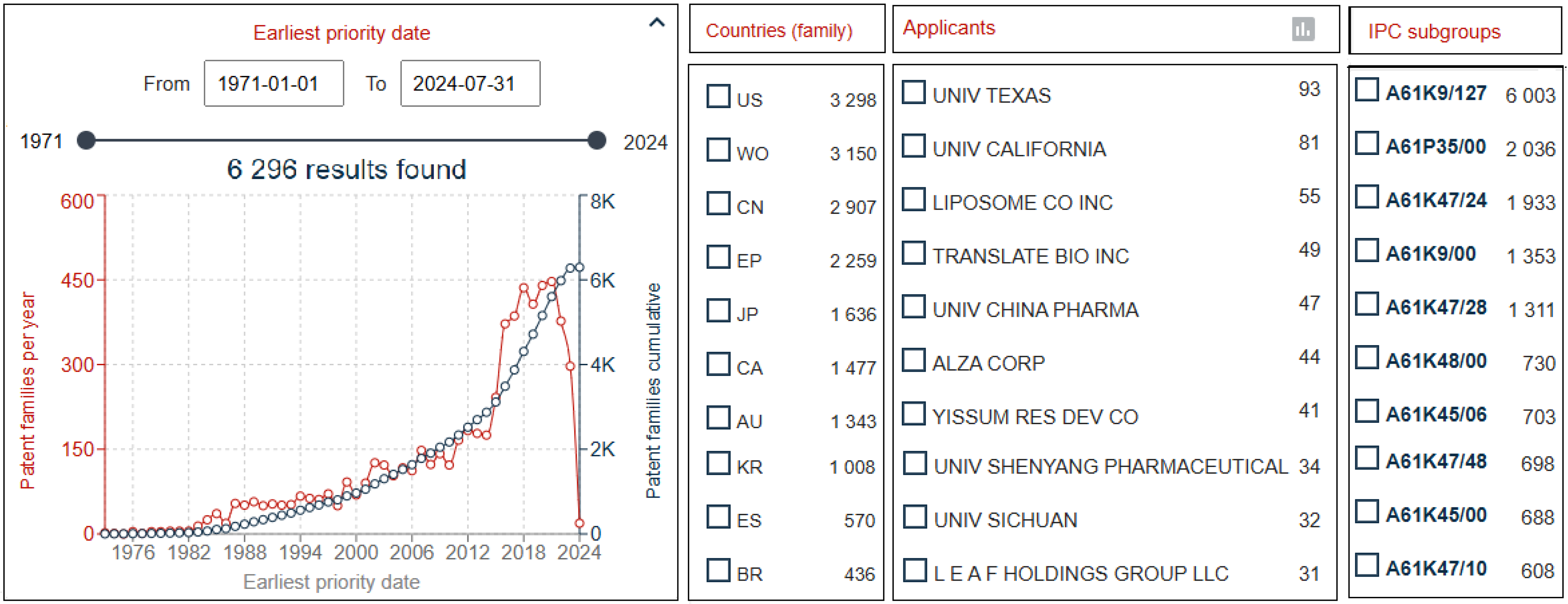
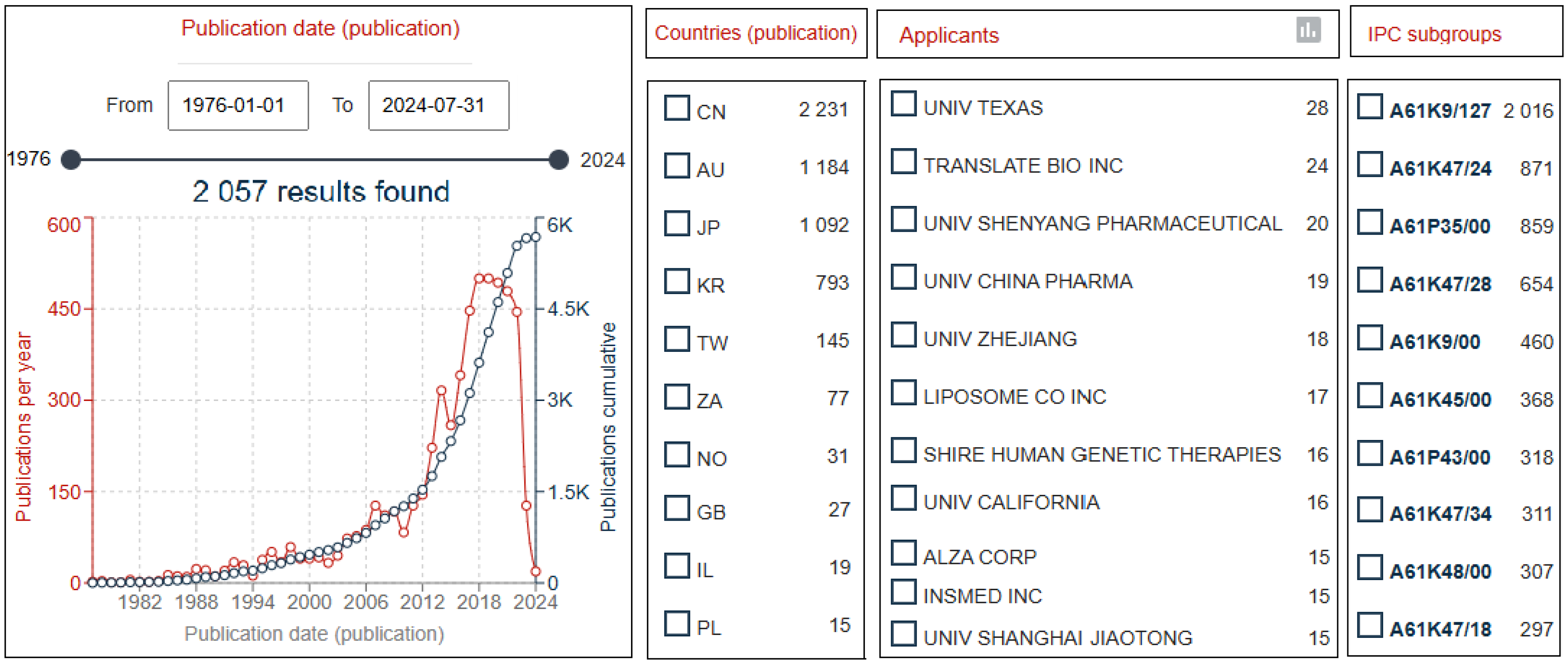

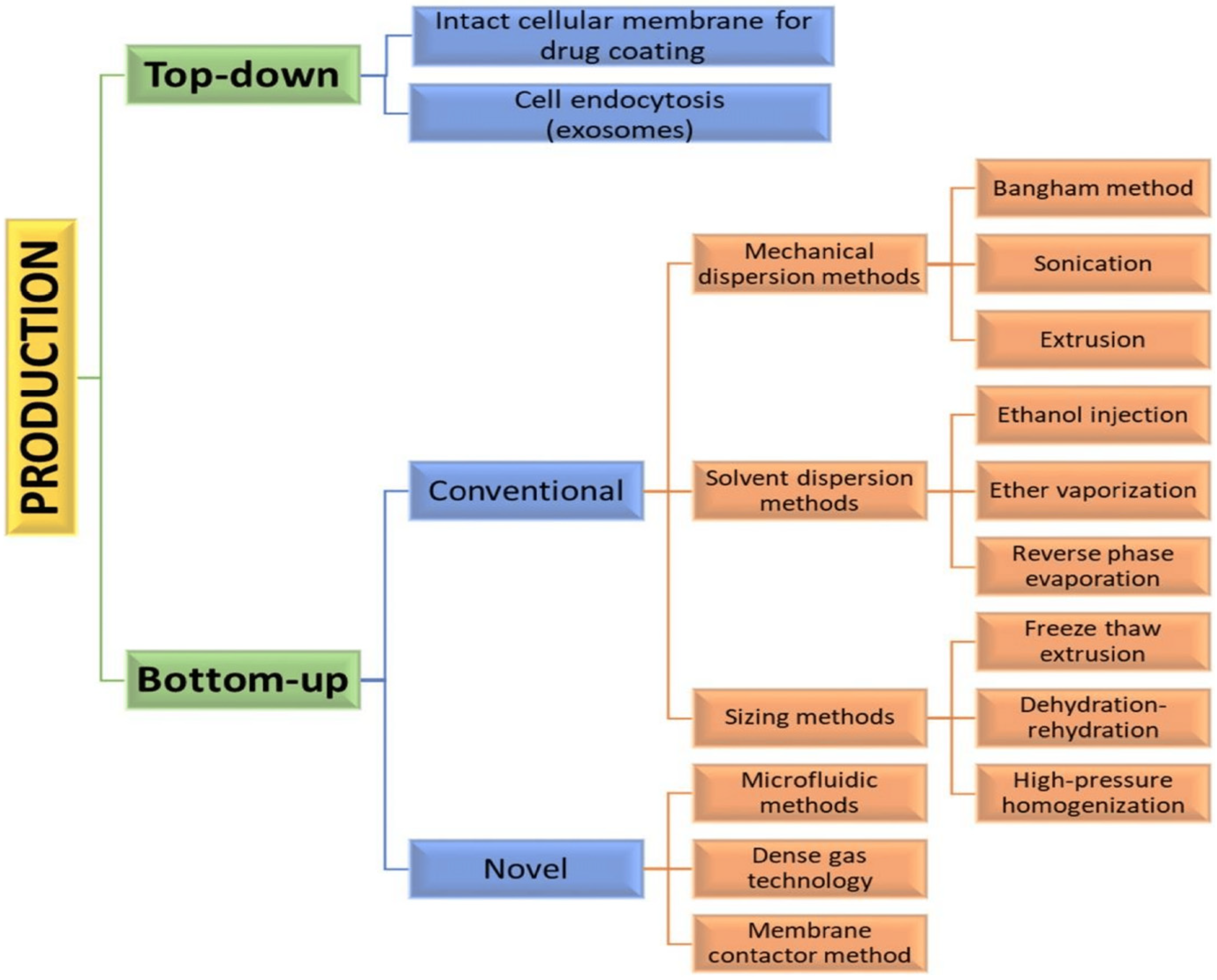
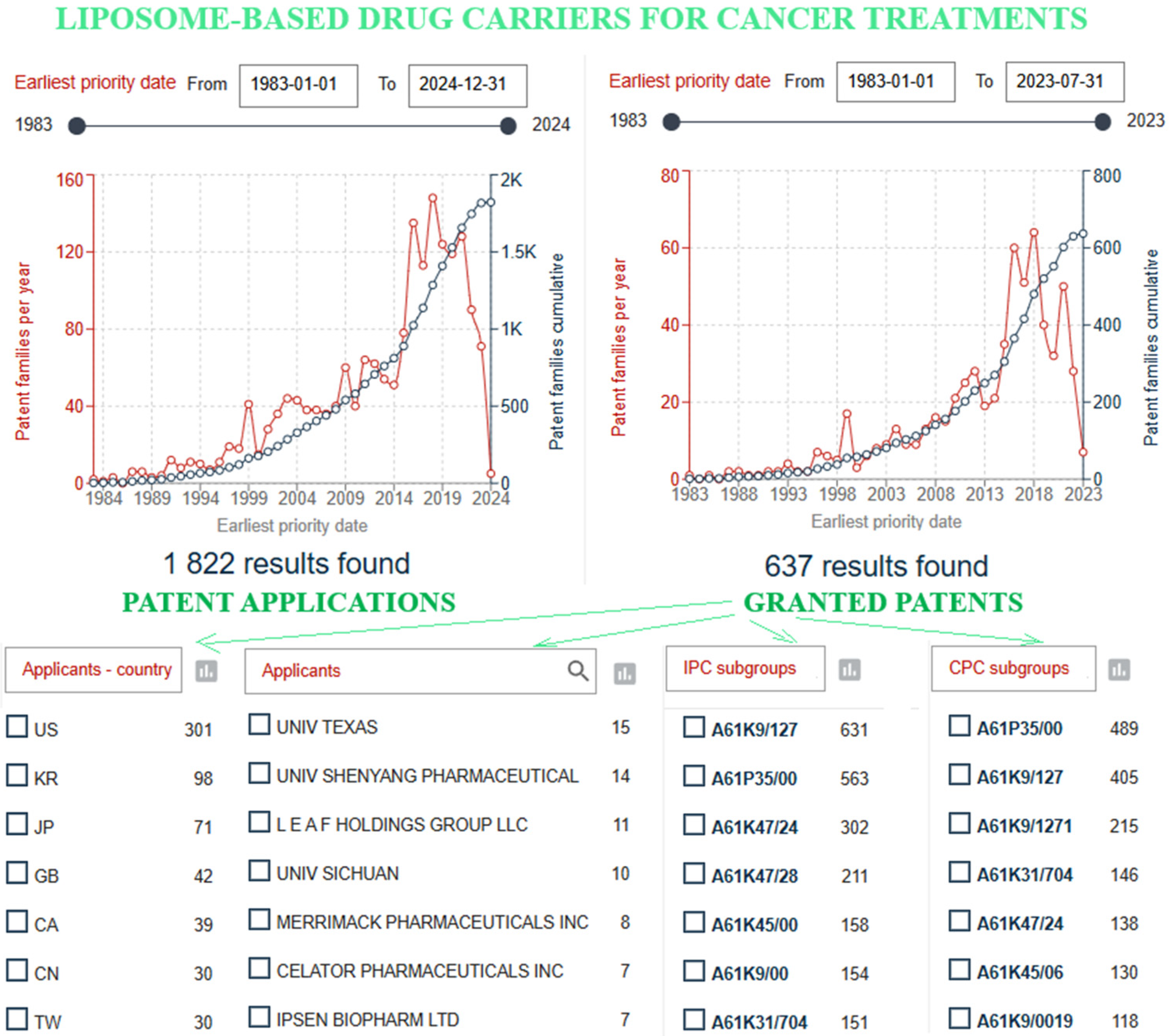

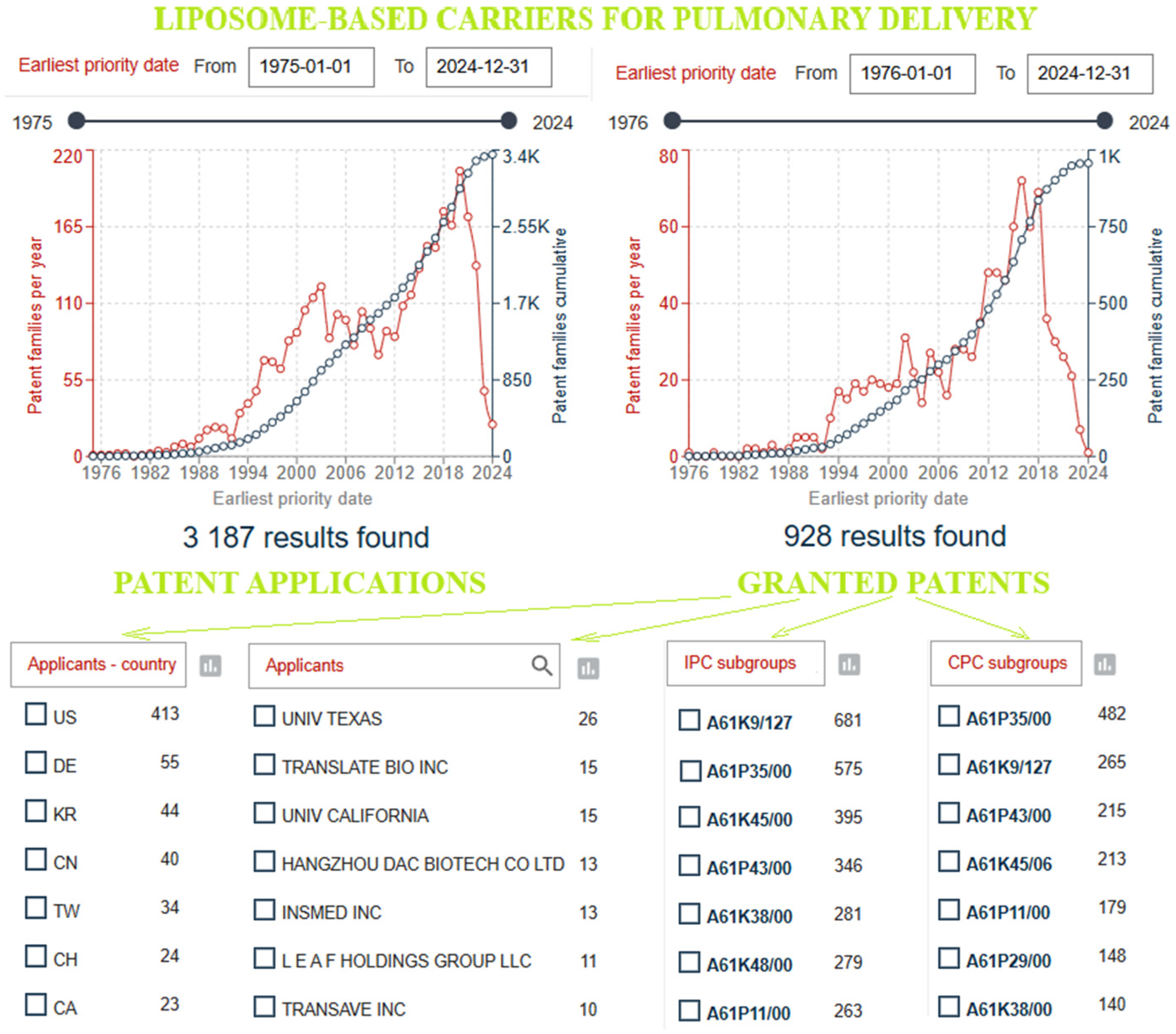
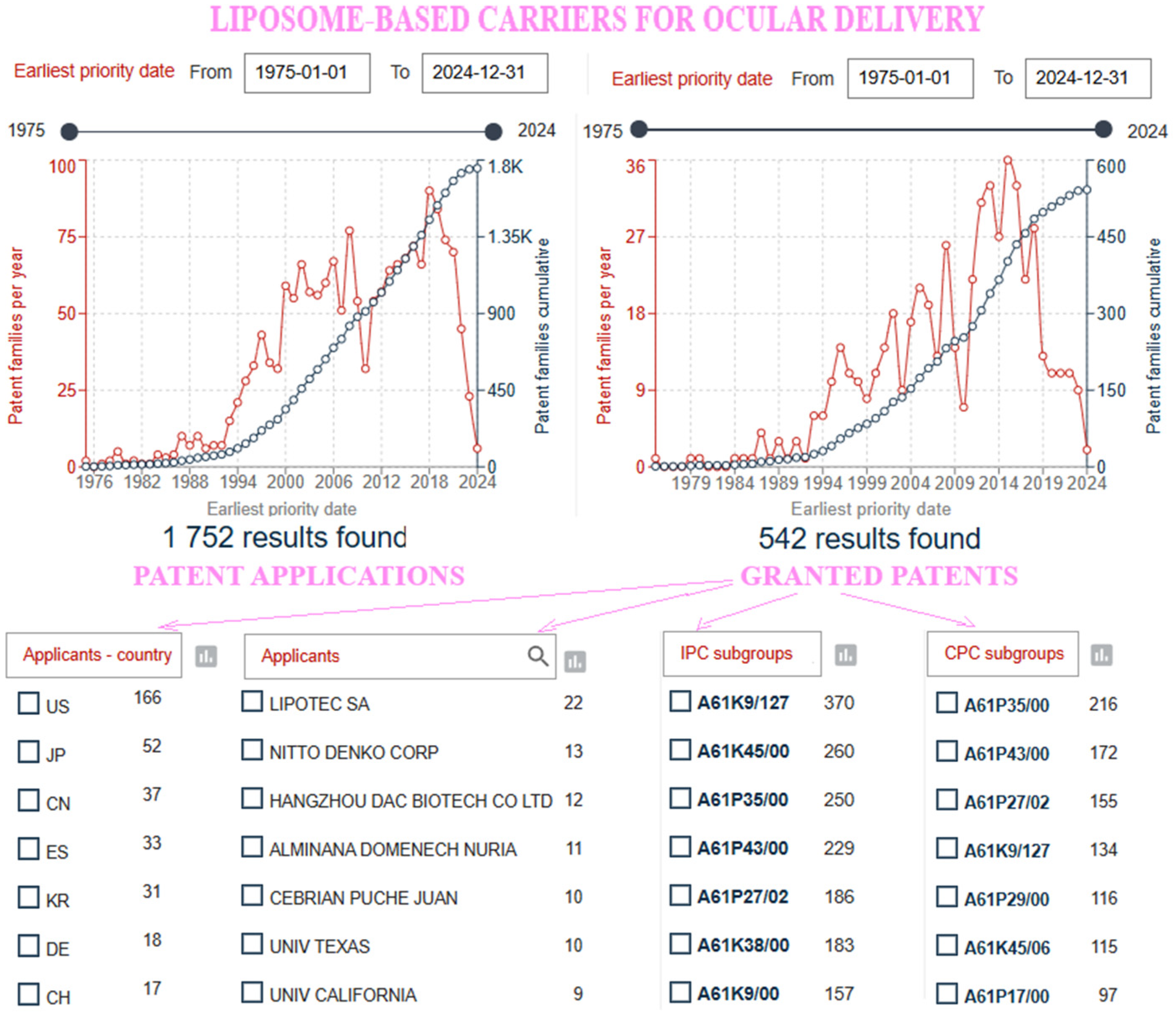
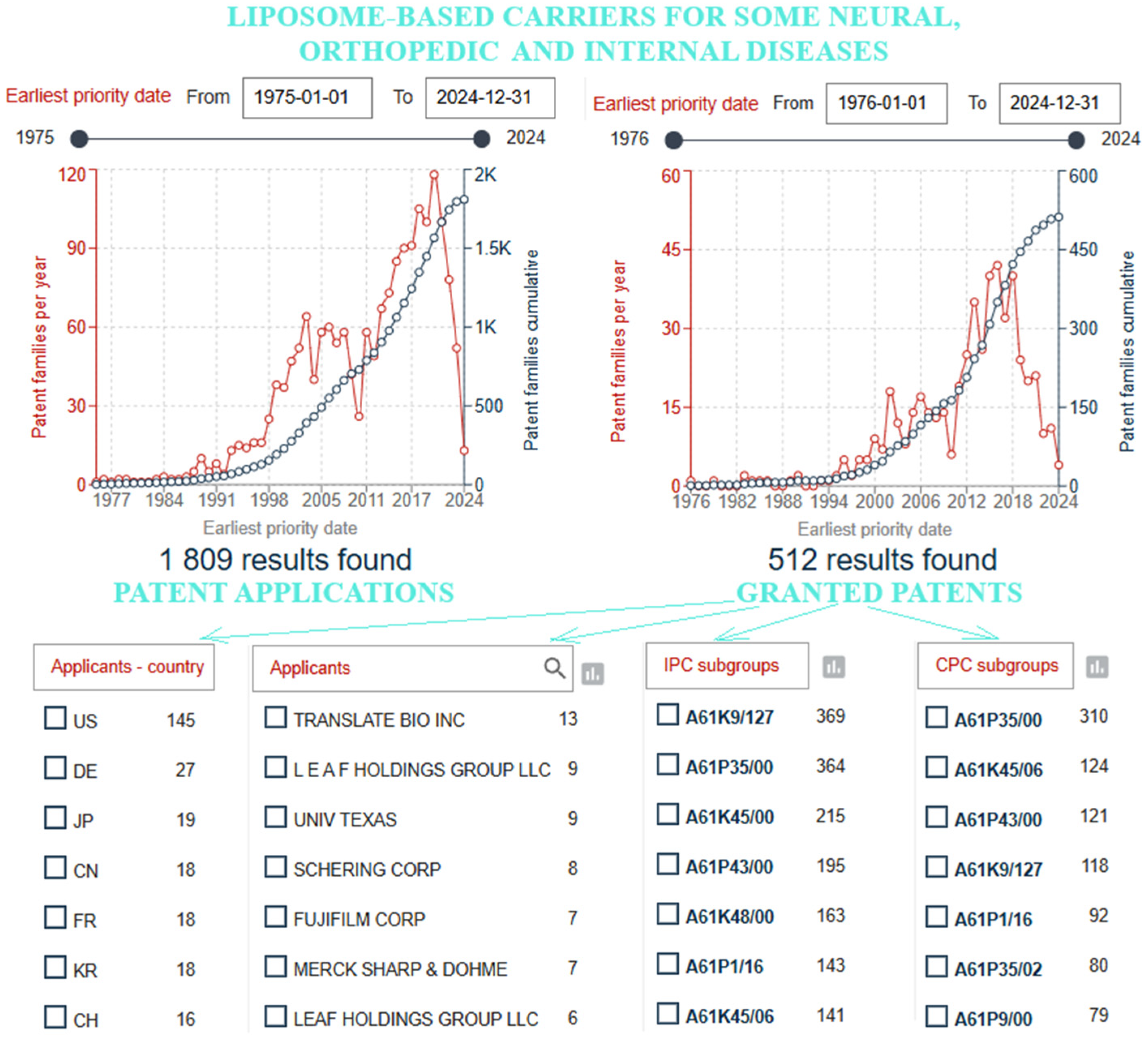
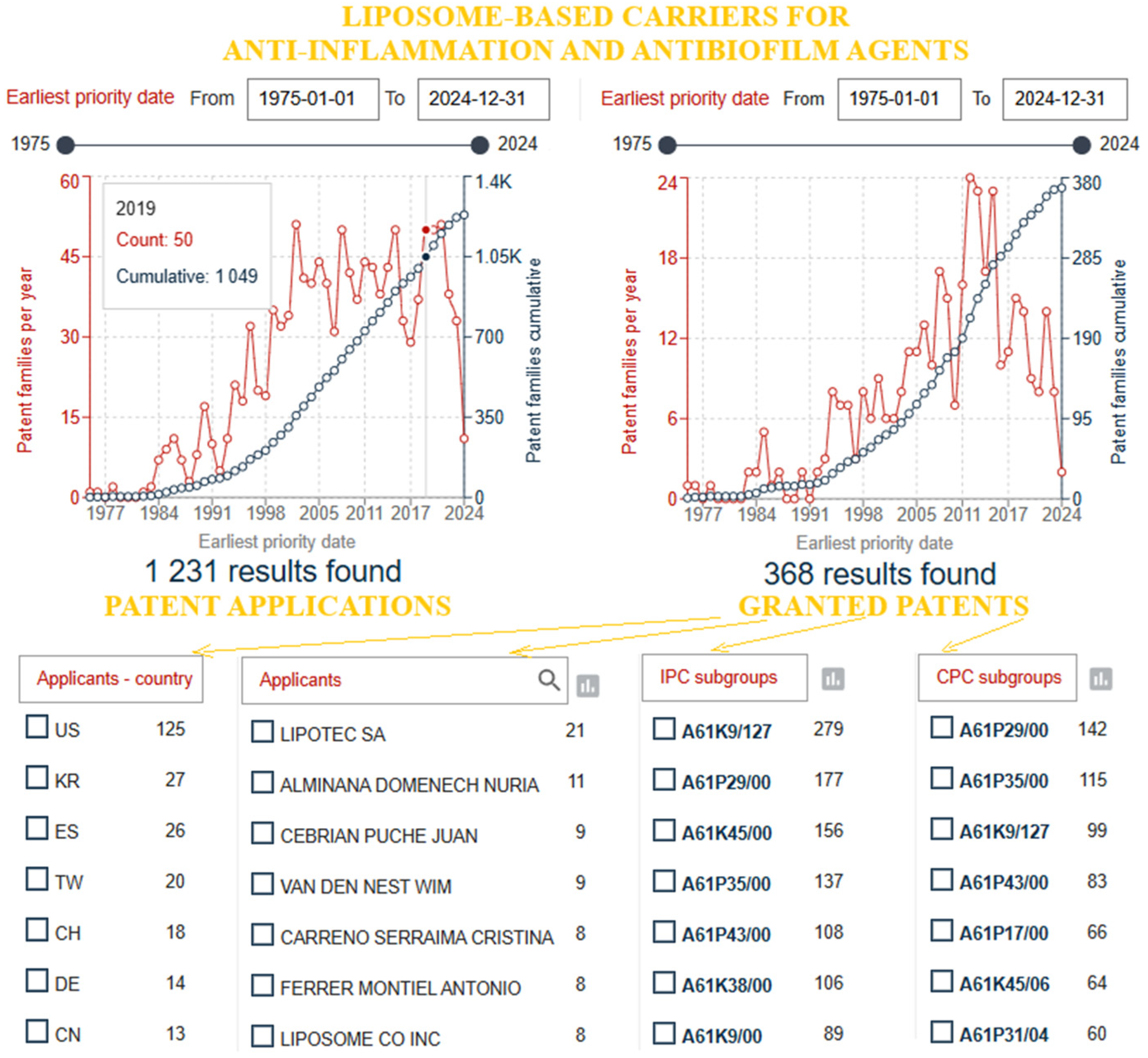
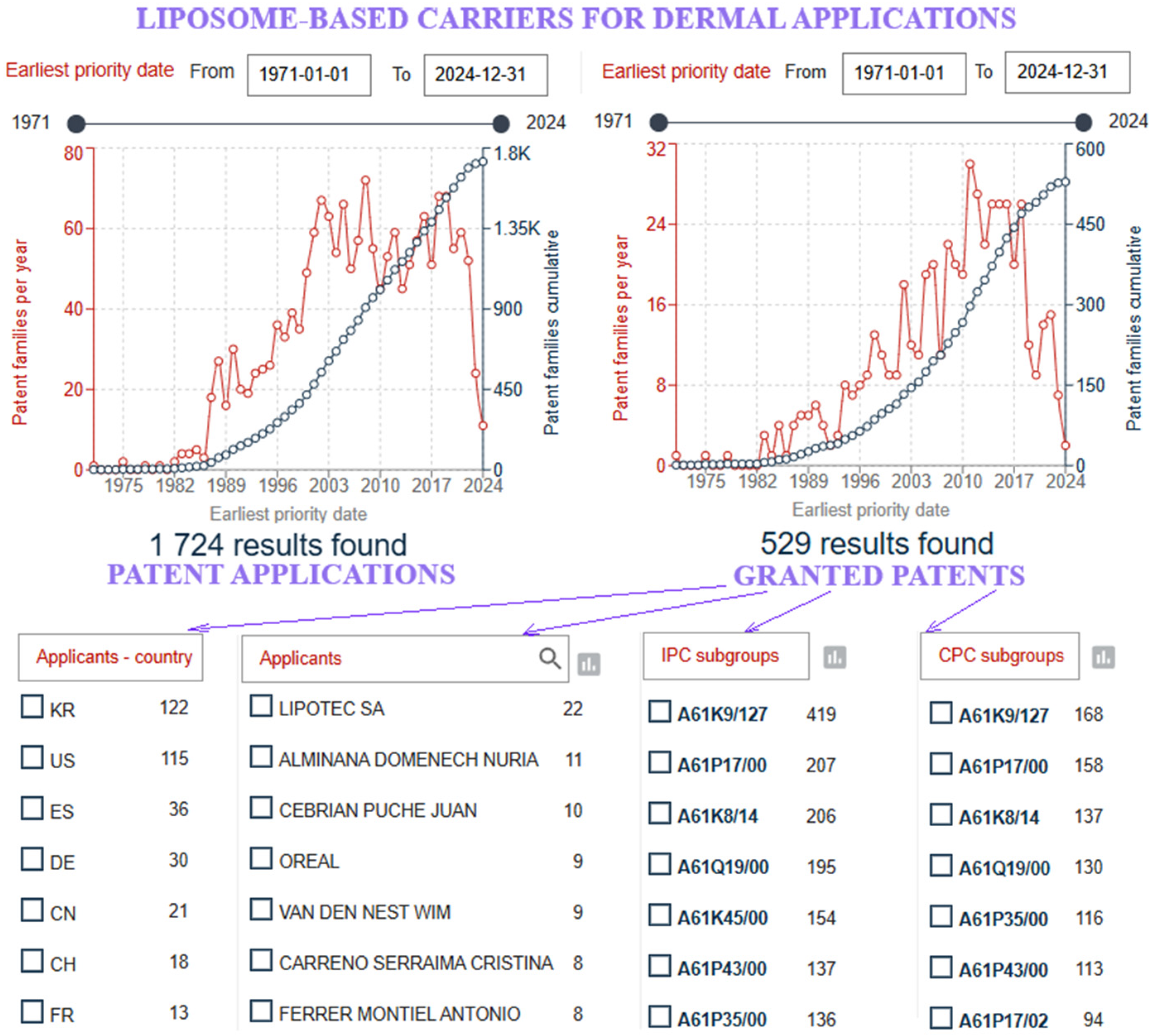
| IPC Code | IPC Description, as Indicated by the Relevant CPC Symbol |
|---|---|
| A61K9/00 | Medicinal preparations characterized by special physical form (…) |
| A61K9/10 | • Dispersions; Emulsions (…) |
| A61K9/127 | •• Liposomes |
| A61K9/1271 | ••• Non-conventional liposomes, e.g., PEGylated liposomes, liposomes coated with polymers (…) |
| A61K9/1272 | •••• With substantial amounts of non-phosphatidyl, i.e., non-acylglycerophosphate, surfactants as bilayer-forming substances, e.g., cationic lipids (…) |
| A61K9/1273 | •••• Polymersomes; Liposomes with polymerizable or polymerized bilayer-forming substances (…) |
| A61K9/1274 | ••• Non-vesicle bilayer structures, e.g., liquid crystals, tubules, cubic phases, cochleates; Sponge phases |
| A61K9/1275 | •••• Lipoproteins; Chylomicrons; Artificial HDL, LDL, VLDL, protein-free species thereof; Precursors thereof |
| A61K9/1276 | •••• Globules of milk or constituents thereof |
| A61K9/1277 | ••• Processes for preparing; Proliposomes |
| A61K9/1278 | •••• Post-loading, e.g., by ion or pH gradient |
| A61K31/00 | Medicinal preparations containing organic active ingredients |
| A61P35/00 | Antineoplastic agents |
| A61K38/00 | Medicinal preparations containing peptides (enzymes, hormones, porphyrin hemoglobin) |
| A61K43/00 | Drugs for specific purposes, not provided for in groups A61P1/00–A61P41/00 |
| A61K45/00 | Medicinal preparations containing active ingredients not provided for in groups A61K31/00–A61K41/00 |
| A61K45/06 | • Mixtures of active ingredients without chemical characterization, e.g., antiphlogistic and cardiac |
| A61K47/00 | Medicinal preparations characterized by the non-active ingredients used, e.g., carriers or inert additives; Targeting or modifying agents chemically bound to the active ingredient |
| A61K47/06 | • Organic compounds, e.g., natural or synthetic hydrocarbons, polyolefins, mineral oil, petrolatum, or ozokerite |
| A61K47/08 | •• Containing oxygen, e.g., ethers, acetals, ketones, quinones, aldehydes, peroxides |
| A61K47/10 | ••• Alcohols; Phenols; Salts thereof, e.g., glycerol; Polyethylene glycols (PEG); Poloxamers; PEG/POE alkyl ethers |
| A61K47/16 | •• Containing nitrogen, e.g., nitro-, nitroso-, azo-compounds, nitriles, cyanates |
| A61K47/18 | ••• Amines; Amides; Urea; Quaternary ammonium compounds; Amino acids; Oligopeptides having up to five amino acids |
| A61K47/24 | •• Containing atoms other than carbon, hydrogen, oxygen, halogen, nitrogen, or sulfur, e.g., cyclomethicone or phospholipids |
| A61K47/28 | •• Steroids, e.g., cholesterol, bile acids, or glycyrrhetinic acid |
| A61K47/34 | •• Macromolecular compounds obtained other than by reactions only involving carbon-to-carbon unsaturated bonds, e.g., polyesters, polyamino acids, polysiloxanes, polyphosphazines, copolymers of polyalkylene glycol, or poloxamers (…) |
| A61K47/48 | • The non-active ingredient being chemically bound to the active ingredient, e.g., polymer drug conjugates (5) |
| A61K48/00 | Medicinal preparations containing genetic material, which is inserted into cells of the living body to treat genetic diseases; Gene therapy |
Disclaimer/Publisher’s Note: The statements, opinions and data contained in all publications are solely those of the individual author(s) and contributor(s) and not of MDPI and/or the editor(s). MDPI and/or the editor(s) disclaim responsibility for any injury to people or property resulting from any ideas, methods, instructions or products referred to in the content. |
© 2024 by the authors. Licensee MDPI, Basel, Switzerland. This article is an open access article distributed under the terms and conditions of the Creative Commons Attribution (CC BY) license (https://creativecommons.org/licenses/by/4.0/).
Share and Cite
Ilić-Stojanović, S.; Cakić, S.; Nikolić, N.; Petrović, S. Innovative and Patented Liposome-Based Drug Carriers. Processes 2024, 12, 1970. https://doi.org/10.3390/pr12091970
Ilić-Stojanović S, Cakić S, Nikolić N, Petrović S. Innovative and Patented Liposome-Based Drug Carriers. Processes. 2024; 12(9):1970. https://doi.org/10.3390/pr12091970
Chicago/Turabian StyleIlić-Stojanović, Snežana, Suzana Cakić, Nada Nikolić, and Slobodan Petrović. 2024. "Innovative and Patented Liposome-Based Drug Carriers" Processes 12, no. 9: 1970. https://doi.org/10.3390/pr12091970
APA StyleIlić-Stojanović, S., Cakić, S., Nikolić, N., & Petrović, S. (2024). Innovative and Patented Liposome-Based Drug Carriers. Processes, 12(9), 1970. https://doi.org/10.3390/pr12091970







